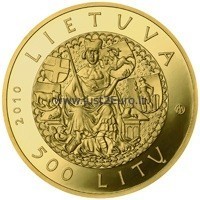500 litų auksinė moneta 2010 Lietuva – Žalgirio mūšis
500 Litų auksinė moneta su dėžute ir sertifikatu
Auksas (Au 999)
Diametras – 33,00 mm
Svoris– 31.10 g
Kokybė proof
Tiražas 5,000
Išleista 2010 metais
Aprašymas
The reverse of the coin features scenes from the Battle of Grunwald, which include details of horsemen and infantrymen clothing, armour and weapons, typical of that time. The inscriptions ŽALGIRIO MŪŠIS (The Battle of Grunwald) and 1410-2010 are arranged in a semicircle.
The obverse of the coins features the majestic seal of Grand Duke Vytautas, encircled by the inscriptions LIETUVA, the year of issue, 2010, and the denomination 500 LITŲ (500 litas).
The 600th anniversary of the Battle of Grunwald is commemorated in 2010. On 15 July 1410, the allied forces of the Polish Kingdom and the Grand Duchy of Lithuania (GDL) defeated the forces of the Teutonic Order thereby putting and end to the epoch of crusades in the Eastern Baltic that had lasted for 200 years. The victory was not only determined by the more numerous forces and successful tactical military decisions of the alliance. In fact, it was the aftermath of the changed geopolitical situation in the region after the 1385–1386 union of Lithuania and Poland and the Christianization of Lithuania in 1387. After accepting Catholic Christianization Lithuania could no longer be an arena for crusades, although the Order for some time tried to continue the usual crusading policy. The Teutonic Order was the first Roman Christian state that Lithuania encountered. Up until the Christianization of Lithuania and long afterwards it remained one of the major factors in Lithuanian history. Permanent wars against the Order that lasted for over a hundred years seriously affected the development of the Lithuanian State. The 14th c. marches to Prussia and Lithuania (Litauerreisen) became an important cultural element of the Western European nobility. For the European knights, marches to Lithuania were not just the fulfilment of certain military tasks, but rather an opportunity to demonstrate their knighthood, and the Order’s leadership managed to create a political and economic organization adapted to the arrangement of these marches and existing on them (servicing of the marchers, the use of the captives for maintenance works, ransoms). On the other hand, the grand dukes of Lithuania, too, found their political and economic solutions combining war economy with the state’s territorial expansion in the East. It is namely in this epoch that Lithuania, which had established itself within the tribal boundaries, expanded into the GDL. In the history of Lithuania, the Teutonic Order has played an ambiguous role too. Constant wars, on the one hand, impeded the expansion of the state’s political structures, yet, on the other hand, the Order’s developed record-keeping and diplomacy was an example followed by the-then rulers of the GDL. Not accidentally, the first international agreements entered into by grand dukes of Lithuania were those with the Order. Major trade routes extended across the Order’s territories, Prussia and Livonia; the influences of European political culture came through these routes too, including the territorial state model adopted over time by the Grand Duchy of Lithuania which was establishing itself as a state.
The Battle of Grunwald made an immense impression on the contemporaries. It was mentioned in major European chronicles of the time and after a few years already the states who had fought in the Battle named it the Great. At the same time care was taken to make the Battle be remembered. Jogaila intended building a monastery on the site of the Battle, yet later, on having abandoned Prussia, he funded the construction of the monastery in honour of the Battle in Lublin. On the recaptured field, the Grand Master erected a chapel in memory of the slain. The Battle symbolised the end of the power of the Teutonic Order, however the weakening of the Order was the outcome of a change in the situation in Europe and Eastern Baltic several decades ago. As a matter of fact, the Order managed to defend its main stronghold then. Heinrich von Plauen, who took over the duties of the Grand Master, organised the defence of Marienburg, and the allies, on having reached the Order’s capital, saw, as it soon turned out, a secure stronghold before their eyes. After the siege that lasted for several months at first Vytautas’, then Jogaila’s troops retreated. The Peace of Thorn signed on 1 February 1411, which ended the war, confirmed the state of affairs. Poland regained the Dobrin Land and Lithuania regained Samogitia for the lifetime of Jogaila and Vytautas. The worst problem for the Order was not the territorial losses but the huge contribution – 100 thousand kapas of Prague groats. The financial obligations of the knights that were much ahead of their possibilities shook the territory’s economy. From then on, the Order did not constitute a military threat, and after the conclusion of the “eternal” Meln Peace Treaty in 1422 (Samogitia was recognised to belong to Lithuania for good) it even became a GDL’s potential ally in the complicated controversy on the consolidation of political sovereignty. The western boundaries with Prussia which for the first time then began to be marked by signs became the state’s most stable borders during the GDL’ entire period of existence.









